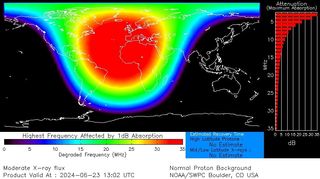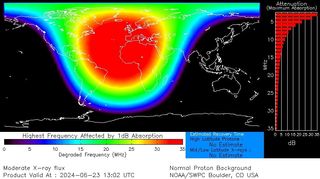The historic sunspot region that sparked the record-breaking auroras of May 2024 has returned in explosive fashion, firing off a colossal M9.3 class solar flare on June 23.
But this isn’t the first time we have encountered this hyperactive sunspot. AR3723 is the returning version of sunspot AR3697 and before that AR3664 — which was responsible for the colossal G5 geomagnetic storm that triggered epic auroras around the world.
The sun‘s rotation period averages 27 days, which means Earth can view a given active region for around two weeks before it rotates over the sun’s western edge. Newly emerging active regions rotating onto the sun’s eastern edge are given a new active region number due to the historical inability to track an active region around the back of the sun.
The sunspot region is making a rare third trip across the Earthside of the sun, but what can we expect from this hyperactive region?
Related: The sun’s magnetic field is about to flip. Here’s what to expect.
Though the sunspot region is only a fraction of its former size, its magnetic makeup continues to produce powerful solar flares. A few days ago on June 23, it unleashed a powerful M9.3-class solar flare, peaking at 9:01 a.m. EDT (1301 GMT). The eruption was just points away from being classified as an X-flare, the most powerful class of solar flare.
“SO NEAR AND YET SO FAR! A new sunspot region on the SE limb just produced an M9.7 flare (just 3% short of an X flare).” Solar physicist Keith Strong wrote in a post on X.
SO NEAR AND YET SO FAR! A new sunspot region on the SE limb just produced an M9.7 flare (just 3% short of an X flare). As it is so far east (i.e., poorly magnetically connect to Earth) it is unlikely to affect us in any significant way. pic.twitter.com/KqK1dRmAesJune 23, 2024
The solar flare triggered moderate shortwave radio blackouts across Western Europe and Africa. Such radio blackouts are common after powerful solar flare eruptions due to the strong pulses of X-rays and extreme ultraviolet radiation emitted during these events. The radiation travels toward Earth at the speed of light and ionizes (gives an electrical charge to) the top of Earth’s atmosphere when it reaches us.

Related stories:
This ionization creates a higher-traffic environment for high-frequency shortwave radio signals to navigate through in order to support communication over long distances. Radio waves that interact with electrons in the ionized layers lose energy due to more frequent collisions, and this can lead to radio signals becoming degraded or completely absorbed.
The historic sunspot region appears to be a creature of habit, once again announcing its presence with a powerful solar flare. When the region previously rotated into view as AR3697, it unleashed an X-class solar flare, triggering radio blackouts across Western Europe and the Eastern United States.
Scientists will be keeping a watchful eye on this region as it produced 28 M-class flares and 6 X-class flares during its last rotation as AR3697. Aurora chasers will be hoping for some strong solar activity in the coming days as the sunspot region turns to face Earth.



